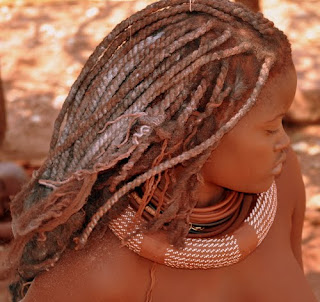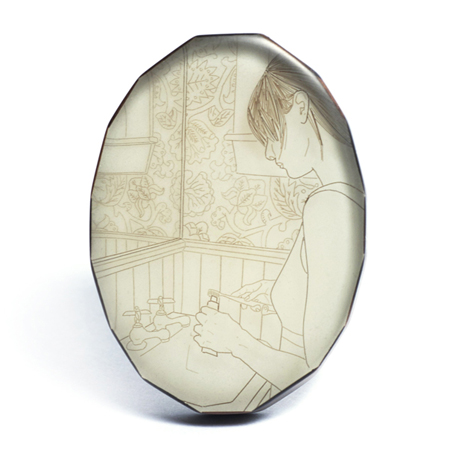Hair is our extended nervous system connected to our brains letting us feel the wind on our scalps. It warns us of danger when the follicles raise their thin flags. Our hair is our fiber nest for our egg of thoughts, keeping
it warm, decorating our mantle and blowing in the breezes of our movements. It
continues growing when we are cold and gone. It collects in our bath drains, It carries our DNA signature and guides forensic specialists to the scene of our crimes.
 |
| Himba Girl, Kunene, Namibia - photo by Daniella TT |
Our hair has worked itself into the current social fabric as well. In our language the references to hair collect like hairballs in the corners of our rooms. A difficult and scratchy endeavor is “wearing a hair shirt”. We have our “bad hair day”, we seek our targets “in the cross hairs”, points of contentions are “splitting hairs”, a close call is “within a hair’s breath”.
Here are some selected artist’s and their works that feature a very small media….made from human hair.
Chrystl Rijkeboer
| HAIR MASK |
 |
| INEVITABLE JOURNEY |
 |
| MEN SCAPE NO. 13 |
 |
| NEST BOXES |
 |
| TWINS BROWN |
Since 1998 Chrystl Rijkeboer has been using human hair as a working material. Out of curiosity
and by experimenting with unorthodox materials she came across this medium. Responses from viewers made her aware of the impact of hair and the emotional charge it contributes to her work. From this the two major themes of work 'Memory and Identity' arose.
'Hair' contains memories. Everyone knows the lock
of hair kept in a medallion or a braid that is kept in an envelope for years
lying in a drawer, memories of our childhood or a lost love. They keep the past
tangible. Everything perishes except for our hair. By a lock of hair you can
literally touch the past.
Our hairstyles emphasize our identity. They can
say a lot about ‘who’ we are, and show our age and health. Prescribed
hairstyles or covering of hair can be a religious statement. With our hair we
show to which ‘group’ we belong or want to belong.
Rijkeboer works mostly thematically and uses
recurring elements including human- and girl figures, birdhouses, ladders,
masks, birds and wolves. These are recognizable images which illustrate stories
about family ties, the living environment and personal experiences. The work is
figurative, but form and proportions are subordinated. What matters are the
sensations evoked. You can always view the work in two ways: kind, pleasant and
innocent. But also the opposite: frightening, condemning and guilty. This ambiguity
repeats itself in all her artworks.
Chrystl uses many craft-based techniques with
hair. First she started to felt it, and later she spun it into threads, from
which she crochets or knits her sculptures. She also combines ceramics with hair.
Besides the 3 dimensional objects she often translates her sculptures and
installations into photographs and video works.
Chrystl Rijkeboer's web site
Melanie Bilenker
Melanie Bilenker makes broach jewelry works featuring line drawings made from her hair. The themes are simple and ordinary moments of her day captured in a line within the miniature framed works.
Melanie Bilenker makes broach jewelry works featuring line drawings made from her hair. The themes are simple and ordinary moments of her day captured in a line within the miniature framed works.
"The Victorians kept lockets of hair and miniature portraits
painted with ground hair and pigment to secure the memory of a lost love. In
much the same way, I secure my memories through photographic images rendered in
lines of my own hair, the physical remnants. I do not reproduce events, but
quiet minutes, the mundane, the domestic, the ordinary moments."
Melanie Bilenker's web site
Adrienne Antonson
The extraordinary miniatures of Adreienne Antonson include the sculpting of insect forms made completely out of human hair.
The extraordinary miniatures of Adreienne Antonson include the sculpting of insect forms made completely out of human hair.
"My sculptural work focuses on making life-like objects from
human hair and other non-traditional fibers. I work with human hair
because of its immediacy, its beauty and flaws. As an artistic material, human
hair is remarkably resourceful. The material never fails to attract and
repulse almost simultaneously, a response I enjoy. As I continue to work with
hair, it encapsulates the survivalist notions I find compelling and am excited
to explore."
An interview with Adrienne Atonson by Effie Bowen for Bomblog - June 10, 2013
An interview with Adrienne Atonson by Effie Bowen for Bomblog - June 10, 2013
EB What is your favorite part about working with
hair?
AA People either love it or they hate it. And I
enjoy that response a lot.
EB What kind of response have you gotten from
someone who hated it?
AA When the insects went viral I would look at
my Google analytics and started reading comments on these sites where people
only write comments if they really love something or really hate it. People
were writing such mean things and you can’t help but be sensitive about it.
Especially me. There were comments from people who hate hair, who think hair is
disgusting—unless it’s on someone’s head, they hate hair. A lot of people also
hate insects and a lot of people hate them both so there were a lot of comments
like, “this is the most disgusting thing,” or, “why would anyone spend their
time making this disgusting filth?”
EB You’ve completely transformed the hair from
what it normally looks like so while there is a “gross out” factor, you are
also tricking us by not having the medium so easily discernable.
AA Yes, I love that people see the bugs and
think that they are real. When I was little I loved Ripley’s.
I’m totally geeking out right now being in Ripley’s Traveling Show next to a car made out of matchsticks.
You can do anything with anything.
EB When you started making the bugs were you
modeling them on real insects or did you make them up?
AA Well the first time I made one I just
thought, Can I do this? I looked at a moth I had in my insect collection and
tried to replicate it. Eventually creative and manufacturing limitations came
up like, Oh his body should be bigger here, and I thought, I can really do
anything I want, these aren’t for a science museum. But I do like the challenge
of replicating something exactly and do it as close as possible and to hold it
in my hand and for it to look real. They really become dares to myself: Can I
do a praying mantis, can I do a housefly?
Adrienne Atonson's web site
Adrienne Atonson's web site
Nagi Noda
“I’ve been obsessing about a little flower made out of human hair,
which came into my possession when I was 17. I found it at an antique shop in
Iceland where I used to work. It had a really big impact on me that this hair
came from a person who had died a long time ago. I kept it in a small box and I
really cherished it. This type of flower is called a Victorian memory flower.
It was very common when somebody died to take the hair and create these types
of flowers on a branch with them. Often there would be a picture of the person
and then the flower in a wreath around the picture. Through the elaboration
with human hair, these pieces offer a far more involving and emotional memory
than a picture only could provide. It is a monument, a relic of this person,
because the hair is coming from the body and it doesn’t decay.
For me hair is the ultimate thread that grows from your body. Hair
is such an original, creative fiber, and sometimes an art form. When it comes
to our hair, we all have to squeeze out some form of creativity. Everybody has
to make a statement of some sort regarding their hair: You have to make a
choice if you cut it or not, simply because it grows. And if you decide to cut
it, you have to go somewhere to get it cut. And then you are always anxious
that it won’t be right. And then there is the drama of the loss of hair. The
Nazis would shave off people’s hair as a way of humiliation. You could go on
and on… It’s been fascinating to me to be able to create an artwork from this
material that is already attached to a person. And I find it at simultaneously
comical, romantic, silly and beautiful.
When we die our hair keeps on growing. It doesn’t make sense, but
there is an element of hope in that, that things continue to grow and are being
one with nature. When I came to New York I was fascinated by all the different
types of hairstyles on people and how much goes into taming it. Hair becomes
like a beast growing on us that has to be tamed. In Hollywood movies women let
down their hair during love scenes, so opening the hair becomes a symbol for
unleashing our sexuality and inner savagery. In many cultures women are wearing
headscarves and burkas to hide their hair, because it is considered very
intimate. Then there is the orthodox Jewish tradition of covering the woman’s
hair with a wig made of someone else’s hair. The more I am investigating and
using hair, the deeper I get into it. It has become a hair fetish or an
obsession of sorts.”
From an interview by Isabel
Kirsch for NY Art Beat August 2008.
Shoplifter's web site
And a little fun from the video studio of Jonathan Gurvit for Sandtander Rio entitled "Hair Conditioner....
















